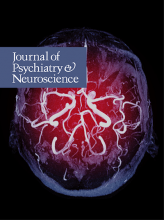A 30-year-old man with a 2-year history of treatment-resistant depression presented for his monthly outpatient psychiatric follow-up. His latest medication trial consisted of escitalopram 20 mg and mirtazapine 30 mg daily for 4 weeks.
The patient was more agitated than usual. He reported physical tension, anxiety and bilateral hand tremor lasting several hours. On examination, he was found to be diaphoretic, hyperthermic (38.6°C), hypertensive (168/92 mm Hg), and tachycardic (104 beats/min) and was promptly directed to the emergency department.
A detailed history revealed that he had taken 100 mg of tramadol that morning, which had recently been prescribed by his family doctor for a musculoskeletal injury. The patient also reported using 1 g of L-tryptophan, an over-the-counter natural product, for depression. Physical examination revealed tremor and provoked myoclonus in both lower extremities. We diagnosed serotonin syndrome, and all serotoninergic medications were stopped. With supportive care, including 2 mg intravenous lorazepam administered every 4 hours, the patient’s symptoms resolved rapidly.
Serotonin syndrome is a potentially life-threatening condition associated with increased serotonergic activity in the central nervous system (CNS).1 While the highest concentrations of serotonin are found in peripheral tissues (platelets and the enterochromaffin cells of the gastrointestinal tract),3 it plays a major role in the CNS, where it is mostly located in the brainstem raphe nuclei and is implicated in the regulation of appetite, sleep, memory, attention, thermoregulation, mood and sexual activity. Peripherally, serotonin modulates coagulation and smooth muscle contraction.2,3,4
The incidence of serotonin syndrome is not well known and is probably underestimated since mild cases can be missed or misdiagnosed.2 Selective serotonin reuptake inhibitors ( SSRIs) are the most commonly implicated agents, and the growing incidence of serotonin syndrome parallels their increasing use.1 While serotonin syndrome often ensues from the combination of at least 2 drugs that increase serotonin activity through 1 or more molecular targets, it can also result from changes in a single serotonergic medication in susceptible individuals (e.g., due to genetic polymorphisms3,5). Most cases of serotonin syndrome develop within a few hours (i.e., 6–24 h) of a medication initiation, change or overdose.1
Pharmacological agents implicated in serotonin syndrome act by increasing serotonin synthesis (e.g., tryptophan, the immediate metabolic precursor of serotonin) or release (e.g., dextroamphetamine); by inhibiting serotonin reuptake (e.g., tramadol, SSRIs, serotonin-norepinephrine reuptake inhibitor [SNRIs]) or catabolism (e.g., monoamine oxidase inhibitors [MAOIs]); by direct agonistic action on serotonin receptors (e.g., fentanyl); or by sensitizing serotonin postsynaptic receptors (e.g., lithium).4 Severe cases of serotonin syndrome are often associated with the use of MAOIs alone or in combination with other serotonin syndrome–inducing agents.1,3
Clinically, serotonin syndrome presents with diverse symptom clusters of varying severity. No symptoms or laboratory findings are pathognomonic.1 The classic serotonin syndrome triad includes altered mental status, autonomic abnormalities and neuromuscular findings.6 Changes in mental status range from anxiety/agitation to hyperactive delirium.1,6 Autonomic manifestations include tachycardia, hypertension, hyperthermia and, in severe cases, unstable pulse and blood pressure.1,6 On physical examination, neuromuscular signs include tremor, hyperreflexia, rigidity, myoclonus and bilateral Babinski signs. Mild cases can present with only subtle symptoms (e.g., restlessness, nausea, mild tremor) that may be misdiagnosed as adverse effects or discontinuation symptoms of common medications, or various other clinical causes.1,6 Algorithms to facilitate the diagnosis of serotonin syndrome, such as the Hunter Serotonin Toxicity Criteria, have proven to be simple and accurate aids.1,6,7
The management of serotonin syndrome is case specific and depends on symptom severity. Symptoms usually resolve within 24 hours of discontinuing serotonin syndrome–inducing agents. Severe cases (presenting, for example, with significant rhabdomyolysis or intravascular coagulation) require intensive medical care1,6
After our patient’s symptoms of serotonin syndrome resolved, he was referred back to our clinic for psychiatric care. While there are no guidelines or high-quality studies to guide clinicians in post–serotonin syndrome care, rational prescribing principles are likely effective in preventing recurrences.8 These principles aim to reduce the total serotonergic load by decreasing doses of — or ideally discontinuing — medications that precipitated the serotonin syndrome.8 Nonserotonergic antidepressants such as mirtazapine and bupropion are possible alternatives.9,10 Most tricyclic antidepressants (e.g., amitriptyline, desipramine and nortriptyline) are also less serotonergic than SSRIs, though clomipramine and imipramine are notable exceptions.9,10 Somewhat surprisingly, SNRIs may confer more risk of serotonin syndrome than SSRIs, possibly because of their distinct mechanisms of serotonin modulation.9 Other possible treatment options include nonpharmacological treatments like neurostimulation, or novel interventions like ketamine infusions.11,12 Psychoeducation for patients about agents with potential for causing serotonin syndrome is also essential.
Most cases of serotonin syndrome could be avoided with careful attention to potentially dangerous drug interactions and vigilance for its highly diverse signs and symptoms.9 As awareness among physicians and patients lags,1 ongoing education remains important.
Footnotes
The information in this column is not intended as a definitive treatment strategy but as a suggested approach for clinicians treating patients with similar histories. Individual cases may vary and should be evaluated carefully before treatment is provided. The patient described in this column is a composite with characteristics of several real patients.
Competing interests: R. Joober sits on the advisory boards and speakers’ bureaus of Pfizer, Janssen Ortho, BMS, Sunovion, Otsuka, Lundbeck, Perdue and Myelin; he has received grant funding from them and from AstraZeneca and HLS. He has received honoraria from Janssen Canada, Shire, Lundbeck, Otsuka, Pfizer and Perdue for CME presentations and royalties from Henry Stewart talks. He is co-editor-in-chief of JPN, but he was not involved in the review of or decision to accept this manuscript for publication. No other competing interests were declared.
This is an Open Access article distributed in accordance with the terms of the Creative Commons Attribution (CC BY-NC-ND 4.0) licence, which permits use, distribution and reproduction in any medium, provided that the original publication is properly cited, the use is noncommercial (i.e., research or educational use), and no modifications or adaptations are made. See: https://creativecommons.org/licenses/by-nc-nd/4.0/









